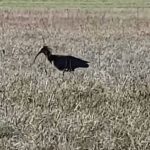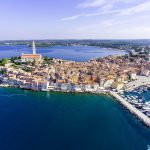Unfortunately, several ornithologists and other bird lovers have recently echoed the news that as many as four Northern bald ibises (Geroniticus eremita) have been killed while flying through Croatia, two of them by poachers.
As Morski writes on the 3rd of January, 2020, this species became extinct in Croatia back in the eighteenth century and the last bird in the country bred in the area of Pula, Istria. Northern bald ibises had the same fate strike them throughout Europe – habitat loss and hunting are considered the main reasons for their disappearance.
At the beginning of the 21st century, the global population of Northern bald ibises was reduced to just 200-250 individuals, which lived in North Africa and in the Middle East. Northern bald ibises are found in many historical sources, and among other things, the ibis is depicted in Egyptian hieroglyphics as “akh” – a symbol of the human soul. Back in the year 1504, these birds were proclaimed one of the first protected bird species in Austria, which unfortunately did not save it from extinction, according to the Biom Association.
In order to preserve the species and return them to their former European breeding sites in Austria, Germany and Spain, reintroduction projects have been launched to try to establish wild Northern bald ibis populations in Europe. Thanks to the excellent work done by a collaborator on the LIFE Northern bald ibis – Reason for Hope project, Northern bald ibises are now breeding again in Germany and Austria, and one of the goals of the project is to teach migratory birds to go to winter resorts in Italy and then come back.
There are currently about 140 individuals in the colonies and since 2014 there has been the organised annual moving of the Northern bald ibises, driven by a motor paraglider. In this way, the young birds learn their migratory journey from their colonies in Austria and Germany to wintering grounds in the Tuscan Oasi Reserve WWF della Laguna di Orbetello. Adult birds that know the way lead the way for new generations, establishing long-term migratory, wild populations of this species.
Recently, at least nine Northern bald ibises from the aforementioned Austrian population, having departed along their usual route, have visited Croatia. However, a visit to Croatia ended tragically for as many as four individuals! It is especially regrettable that two males – Donatello and Terras, appear to have been killed by poachers.
”This is not only a significant loss for the project, but it also indicates that poaching in Croatia is a major threat to biodiversity,” said Johannes Fritz, general manager of the Northern bald ibis reintroduction project.
”We will take every opportunity to locate the perpetrators, as we do in Italy in these cases. We estimate monetary damages for Donatella and Terras at 33,600 euros, and we’re ready to sue the perpetrators – Bird casualties have been established thanks to satellite tracking technology for bird movements. Data from GPS transmitters and field research indicate that the birds were killed and the GPS devices they carried were taken off and hidden in the bushes. The surviving birds were successfully captured and taken to safety outside of Croatia,” he noted.
On top of that, we learn that losing Donatello is a particularly hard blow.
”Donatello hatched in 2015 at Rosegg Zoo. He was raised by hand and was part of a flock run by a motor paraglider on the migration route to the winter resort in Tuscany. He was released there. In 2018, he flew independently to a breeding colony in Burghausen. He was an experienced bird-guide capable of leading young generations to wintering grounds, that is, a good foundation for establishing a wild population. Terras was a young male, accompanying adult birds during the migration.
”We’re extremely sorry that the main obstacles to the conservation of endangered species remain human misinformation and negligence leading to non-compliance. For many years, the Biom association has been warning about the problem of poaching in Croatia. The example of the suffering of Northern bald ibises is just one of the indicators of how much work is still ahead of us when it comes to curbing and preventing the poaching of birds,” concludeed Biom Ornithologist Ivan Budinski.
Make sure to follow our lifestyle page for more.










